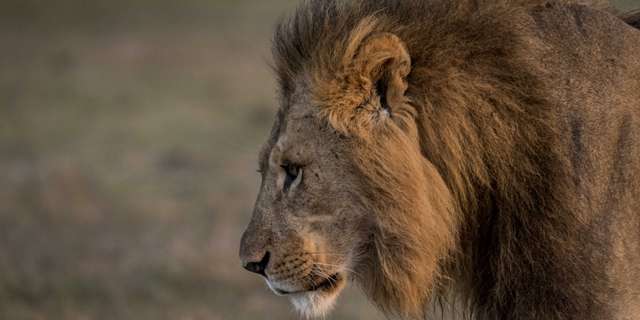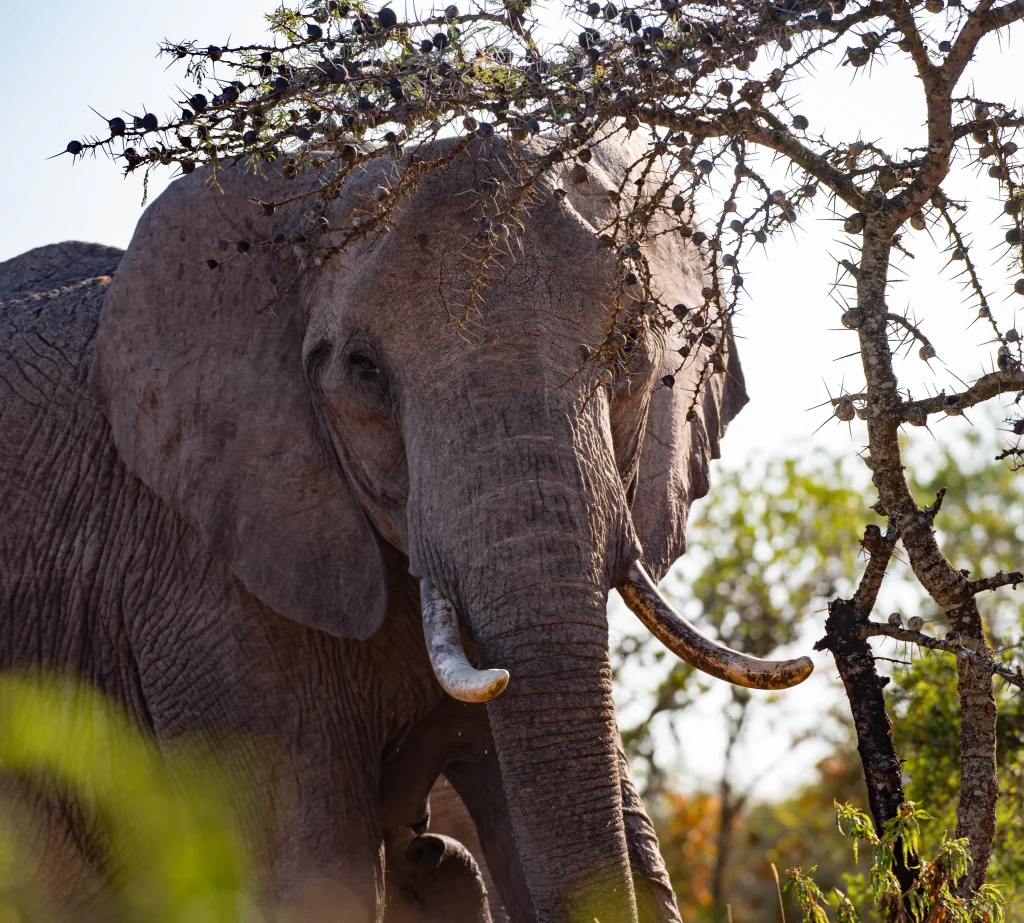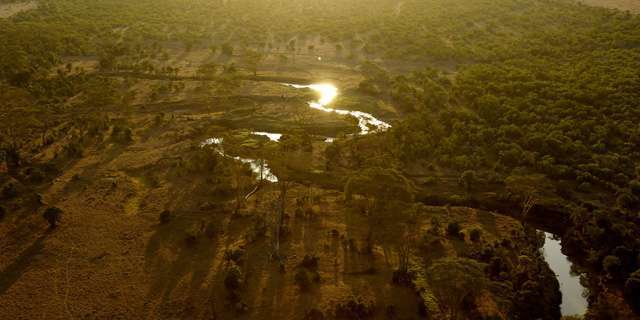WILDLIFE AND HABITATS
The Laikipia region has the richest diversity of wildlife in Kenya outside of the Maasai Mara – and protected areas like Ol Pejeta are key to conserving this natural wonder.
Our innovative fencing techniques allow wide-ranging species like elephant and wild dog to migrate through Ol Pejeta to neighbouring ranches and conservancies, while at the same time keeping our rhino secure. Ol Pejeta’s 90,000 acres is grazed by wildlife and livestock, in a partnership that is as beneficial to the grasslands as it is to the animals.
WILDLIFE & HABITATS
PREDATORS

The Ol Pejeta Conservancy holds some of the highest predator densities in Kenya. The lions are the most numerous of our big cats, with six resident prides bringing the total lion population to 72. The Conservancy is also home to around 30 cheetah, and 20 elusive leopard. Spotted hyena (population around 100), black-backed jackal, caracal and the bat-eared fox can also be found here. Since 2011, there have been regular sighting of two packs of African wild dogs on Ol Pejeta, totalling 33 individuals. This is a promising sign for Laikipia as numbers of this endangered species continue to decline. In 2014, this migratory pack chose to have a litter of puppies on Ol Pejeta, causing much excitement for our Ecological Monitoring Unit (EMU), and for tourists too.
The Ol Pejeta’s EMU strives to collect as much species-specific information on the Conservancy’s predators as possible. There are many ways they do this, such as tracking collared lions and setting camera traps. This information helps experts build up a picture of population sizes, home ranges and behaviour patterns, all of which ultimately helps to provide conservation solutions.
If you want to get your hands dirty with on-the-ground conservation that can have a real impact on Kenya’s wildlife, then sign yourself up to go lion tracking with one of Ol Pejeta’s lion rangers. You will help track collared lions using a receiver, and gather information on each individual pride member. You will be directly contributing to lion conservation, while having a once-in-a-lifetime experience.
WILDLIFE & HABITATS
ENDANGERED SPECIES
Ol Pejeta’s mission to safeguard vulnerable species extends far beyond black rhino and chimpanzees. Other vulnerable or endangered species that live here include elephant, African wild dog, cheetah, lion, leopard, hippo, Grevy’s zebra and the locally threatened Jackson’s hartebeest.
African wild dog (Lycaon pictus):
The African wild dog’s multi-coloured coat earned it its Latin name, which translates to ‘painted wolf’. This unusual coat and their large rounded ears are perhaps the two most distinguishable features that set it apart from domestic dogs. They are very social animals, and live in packs dominated by a monogamous breeding pair. They are ruthless and efficient hunters; packs of up to 20 can cooperate to take down prey as big as wildebeests. These animals are nomadic, which is why seeing them on Ol Pejeta is always a treat.
African wild dogs are listed as endangered by IUCN, with the wild population considered to be around 6,600. They are facing drastic habitat loss as human settlements expand, as well as persecution from livestock owners trying to protect their stock. Wild dogs are also vulnerable to many of the diseases that affect domestic dogs, and these can have devastating consequences on entire packs.
In May 2011, a pack of nine wild dogs started making a regular appearance on Ol Pejeta. Since then, the migrant population here has grown to an impressive 32 individuals spread across two packs. Between them, the packs have produced 18 pups. With a solid supply of prey and protected rangelands, Ol Pejeta is the ideal habitat for these animals. Through strategic fencing, we have worked hard to reduce the risk of the dogs running into conflict with neighbouring communities, and to reduce the risk of local pastoralists losing their cattle to hungry packs. We also work closely with the KWS veterinary units to attend to any injuries or illnesses. We even acted as wild dog lifeguards in 2014, when several puppies fell into a cattle trough and couldn’t get out.
Wild dogs have since moved out of Ol Pejeta and last GPS fix was at Lake Baringo. Occasionally, 1-3 individuals are sighted.
Did you know? African wild dogs have only four toes per foot, unlike other dogs, which have five toes on their forefeet.
WILDLIFE & HABITATS
ELEPHANTS

Loxodonta africana)
The African elephant is the largest land mammal on earth, but these gentle giants are listed as vulnerable by IUCN due to widespread poaching for their ivory. Elephants have a complex social structure, and live in herds led by a matriarch, or dominant female. Traditionally, they follow seasonal migration patterns, travelling huge distances to find food and water. As such, there is no resident population of elephants on Ol Pejeta, but there can be up to 300 at any one time.
The Conservancy has incorporated wildlife corridors within its northern boundary fence to ensure migratory animals like elephants can move safely out of Ol Pejeta to the greater Laikipia/Samburu ecosystem.
These innovative corridors allow free movement of all species on the Conservancy except for rhinos.
A few infamous elephants have to be closely observed by Ol Pejeta’s Ecological Monitoring Unit, due to their habit of breaking fences and raiding crops on neighbouring farms. Notorious “fence- breakers” may have their tusks shortened, which has shown to significantly reduce the rate of fence breakage.
WILDLIFE & HABITATS
HABITATS

There are five main types of habitat on Ol Pejeta, and this diversity contributes to the wide variety of wildlife found here.
- Grasslands cover approximately 24% of Ol Pejeta, dominated by Themeda triandra, Penisetum stramineum and Penisetum mezianum
- Open bush land covers approximately 25% of Ol Pejeta, dominated by Acaciadrepanolobium
- Dense bush land covers approximately 49% of Ol Pejeta, dominated by Eucleadivinorum
- Riverine habitat covers approximately 2% of Ol Pejeta, dominated by Acaciaxanthophloea
- Swamp/ marsh land also features in Ol Pejeta, and is a habitat dominated by Cyperus
Why is it important?
The Acacia drepanolobium dominates the open bushland habitat covers 53% of Ol Pejeta’s 90,000 acres. This acacia is also known as the ‘whistling thorn’ – so called because of the sound the gall fruit makes when the wind blows through it. It is one of the most important habitats for Ol Pejeta’s black rhino as it is their primary food source.
The gall fruits of the Acacia drepanolobium are home to at least four different types of ants, which enjoy a symbiotic relationship with the acacia. The ants feed on a sweet sucrose-rich solution produced by the tree and, in return, protect the acacia by attacking any browsing predators such as giraffes. The tree is also home to the Patas monkey, who feed on the ants.
What is Ol Pejeta doing to protect it?
As well as being a food source for giraffe and black rhino, the Acacia drepanolobium is also eaten by elephants. These mega herbivores can cause large-scale destruction to open bush land habitat, and to investigate the effect this might have on wildlife, Ol Pejeta has established a monitoring programme in collaboration with Earth monitor Project. So far, about four A. drepanolobium exclusion zones have been established, which prevent elephants from accessing the trees. These zones were established in areas where low survival and high tree damage rates were recorded, to allow these trees to reach maturity. Tree planting was also carried out in these exclusion areas.
What is it?
Dense bush land in Ol Pejeta is predominantly covered in Euclea divinorum (Euclea) – a fast establishing, unpalatable, fire resistant bush that is considered an invasive species in some parts of its range. Euclea bushes cover approximately 27% of Ol Pejeta’s total area, and has been gradually expanding in coverage over the past few years. So much so, that the tree is encroaching into A. drepanolobium (whistling thorn) woodlands; a key woody habitat for the endangered black rhino. The whistling thorn has been shown not to thrive in areas where Euclea has taken over, which is of concern to many conservationists. However, the Euclea has been observed to protect other woody species for grazing herbivores, due to its unpalatable nature.
What is Ol Pejeta doing about it?
Ol Pejeta is currently looking at establishing experimental plots to aid in identifying the best approach for controlling Euclea. Given that there is high woody species diversity in areas where it is present, Ol Pejeta propose to collaborate with a third party researcher to discover the control method with the least ecological impacts.
Why is it important?
Grass provides forage both domestic and wild grazers including the white rhino, and is a vital part of the Ol Pejeta ecosystem. Ol Pejeta uses livestock as an ecological tool to manage the grassland for the benefit of wildlife – in an innovative approach that allows wild grazers to benefit from nutrient rich grass as well as allowing the Conservancy to make an income from cattle farming.
What is Ol Pejeta doing to protect it?
The grasslands of Ol Pejeta frequently suffer from drought and overgrazing. Our Ecological Monitoring Unit (EMU) has established a proactive and adaptive management plan, and consistent habitat monitoring process. The conservancy is divided into 97 grazing blocks. EMU gathers information on the grassland conditions and dynamics and assess the potential of grazing or suitability for use for each block. This way, the unit can advise the livestock department on which blocks to graze on and which ones not to. The unit also advices on the intensisy and extensiveness of the grazing to be applied per block. This in turn helps to deal with overgrazing at any particular time.
Why are they important?
The riverine habitat covers about 5% of OPC habitat. Acacia xanthophloea (yellow fever tree) constitute the largest proportion of this habitat. These trees provide both food and shelter for many herbivores including giraffe, elephant, olive baboon and velvet monkeys.
Elephants are largely responsible for the destruction and degradation of yellow fever woodlands in Ol Pejeta. Elephants snap, strip and push over mature trees looking for food, and in large numbers can cause serious damage. Exposing the woody tissue of the tree by stripping the bark leave the tree susceptible to attack by boring beetles and other insects, which can eventually lead to the death of the yellow fever.
How is OPC protecting them?
The riverine habitat falls under the ‘special conservation zone’ in the Ol Pejeta Conservancy 2020 Land Use Plan. This plan will see stretches of woodland along the Ewaso Ngiro and Ngobit rivers be rehabilitated by reseeding, and these areas excluded from all browsers. Ol Pejeta hopes to erect protective game fencing around 3-5 hectare plots where a variety of riverine tree species are planted. Several exclusion zones have already been established in some high priority areas to limit access by the herbivores, and yellow fever seedlings have been replanted to complement natural regeneration.
Why are they important?
The marsh area supports a large variety of aquatic species; including birds, insects and herbivores such as waterbuck and elephant. Not much data has been gathered about the ecology of Ol Pejeta’s marshlands, and the Conservancy would welcome third party researchers with which to collaborate on this.
How is OPC protecting them?
The swamp also falls under the ‘special conservation zone’ in the Ol Pejeta Conservancy 2020 Land Use Plan. Ol Pejeta proposes to create additional swamps and marshes on the Kongoni, Murera, Kamok, Sidai and Loirugurugu drainage lines where water is impounded, so that water levels can be regulated to form a variety of habitats.
